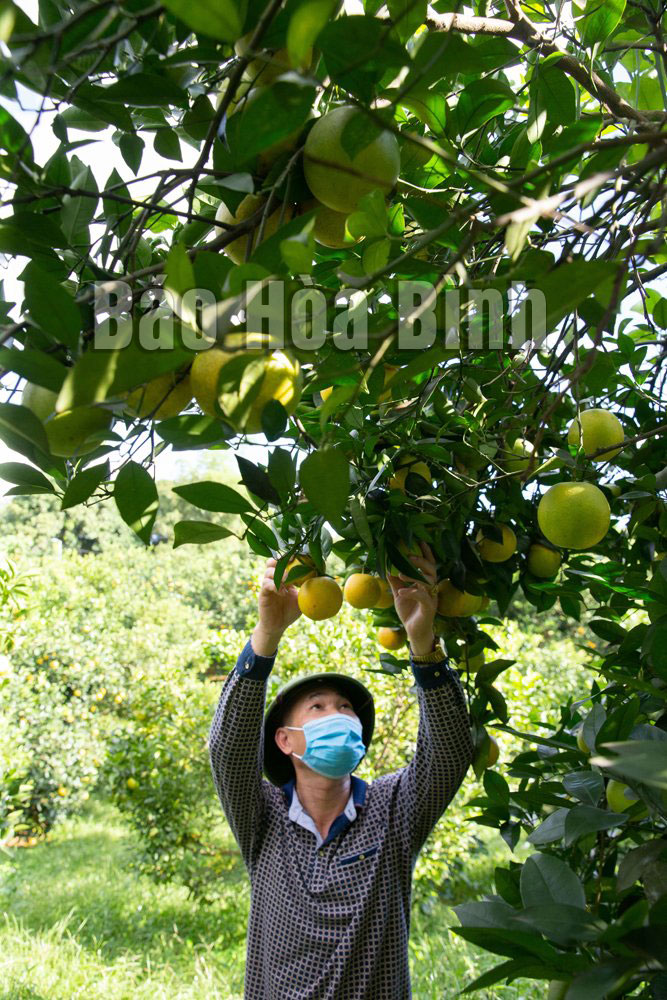
(HBO) - For a long time, Cao Phong orange has been known as a specialty of Hoa Binh province thanks to its superior quality compared to many similar products in the market. In particular, this kind of orange is one of the five agricultural products of the province that are included in Vietnam’s Top Gift Specialties and Products in the 2021 – 2022 period by the Vietnam Record Organisation.

Residents in Cao Phong
district invest in orange cultivation in accordance with safety standards.
Agriculturists said that the specific geographical
conditions and the cultivation skills of local people have helped increase the
quality of Cao Phong orange. The sloping topography of Cao Phong orange area
makes water well drained, which is suitable for tree growth. In addition, the
temperature in the district is always about 10 degrees Celcius lower than the
lowland. In particular, low temperatures during the fruiting period from late
March to early April facilitate the conversion of starch into sugar. Therefore,
Cao Phong orange has a sweeter and less sour taste than others.
In addition to geographical factors, the quality of this
kind of orange is also determined by the cultivation techniques of local
people. In 2012, Cao Phong district conducted the development of geographical
indications of "Cao Phong" for its orange products. On November 5,
2014, the National Office of Intellectual Property issued GI Registration
Certificate No.00046 for orange product of Cao Phong district. It continued to
be managed and developed after protection through the project on the management
and development of geographical indications for Cao Phong orange of Hoa Binh
province. The district has also taken many measures to link production in
accordance with safe production standards, with advanced science and technology
application to take proper care of the fruit. Therefore, the quality of the
fruit improves continuously.
In 2016, Cao Phong orange entered the Top 10 famous brands.
This fruit is selected as a dessert serving passengers of Vietnam Airlines and
is present in many major supermarket chains across the country.
In the 2022-2023 crop, Cao Phong district is currently
growing orange on about 1,500 hectares, with an expected output of about 18,000
tonnes, of which the area of orange produced according to VietGAP standards is
about 536.7 hectares. In order to improve the quality of this fruit, the
district People's Committee is implementing a project to replant citrus in Cao
Phong district, for 2021 - 2025, together with other specific solutions./.
According to data from the Hoa Binh Provincial Party Committee, the industrial production index for the first six months of 2025 is estimated to have increased by 20% compared to the same period last year. This marks the highest year-on-year growth rate for this period since 2020.
In the first six months of 2025, Hoa Binh province’s export turnover was estimated at 1.145 billion USD, marking an 18.11% increase compared to the same period in 2024. Import turnover was estimated at $ 804 million, a 17.15% increase, which helped the province maintain a positive trade balance.
The lives of the ethnic minority farmers in Tan Lac district have gradually improved thanks to the new directions in agricultural production. This is a testament to the collective strength fostered through the professional associations and groups implemented by various levels of the district’s Farmers’ Union.
With the motto the "product quality comes first,” after nearly one year of establishment and operation, Muong village’s Clean Food Agricultural and Commercial Cooperative, located in Cau Hamlet, Hung Son Commune (Kim Boi district), has launched reputable, high-quality agricultural products to the market that are well-received by consumers. The products such as Muong village’s pork sausage, salt-cured chicken, and salt-cured pork hocks have gradually carved out a place in the market and they are on the path to obtaining the OCOP certification.
In the past, the phrase "bumper harvest, rock-bottom prices" was a familiar refrain for Vietnamese farmers engaged in fragmented, small-scale agriculture. But today, a new spirit is emerging across rural areas of Hoa Binh province - one of collaboration, organisation, and collective economic models that provide a stable foundation for production.
Maintaining growing area codes and packing facility codes in accordance with regulations is a mandatory requirement for agricultural products to be eligible for export. Recently, the Department of Agriculture and Environment of Hoa Binh province has intensified technical supervision of designated farming areas and packing facilities to safeguard the "green passport" that enables its products to access international markets.



